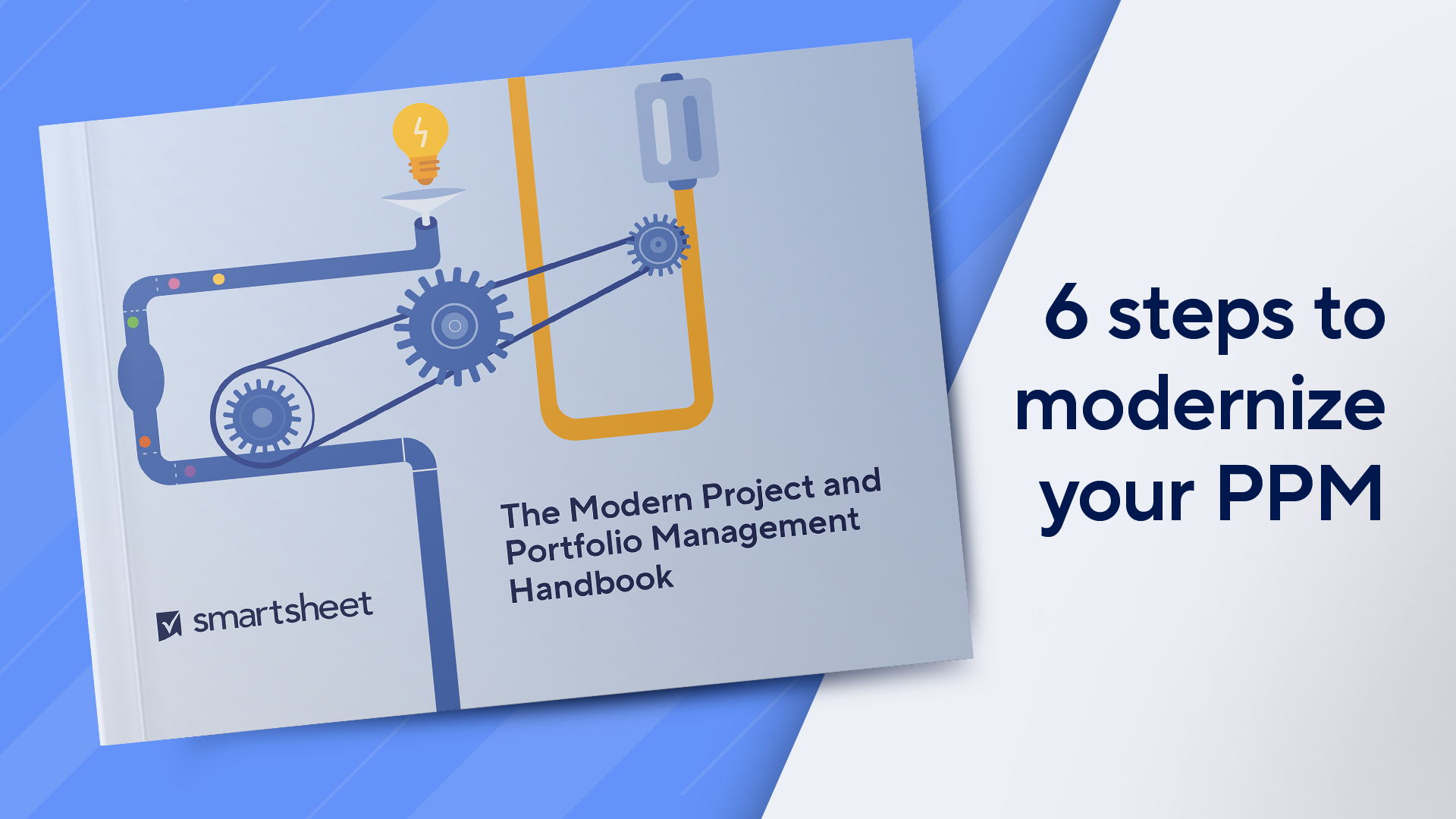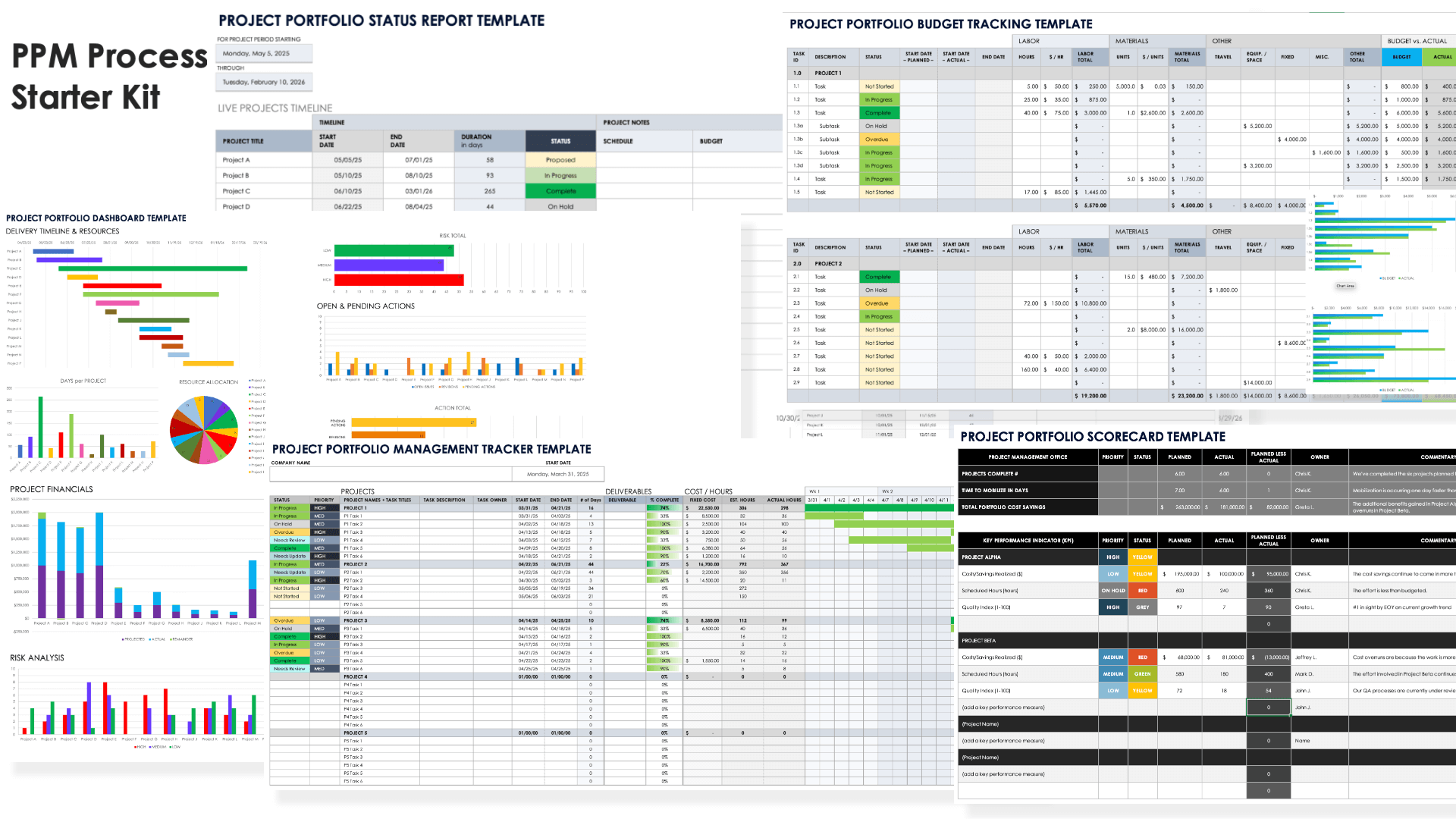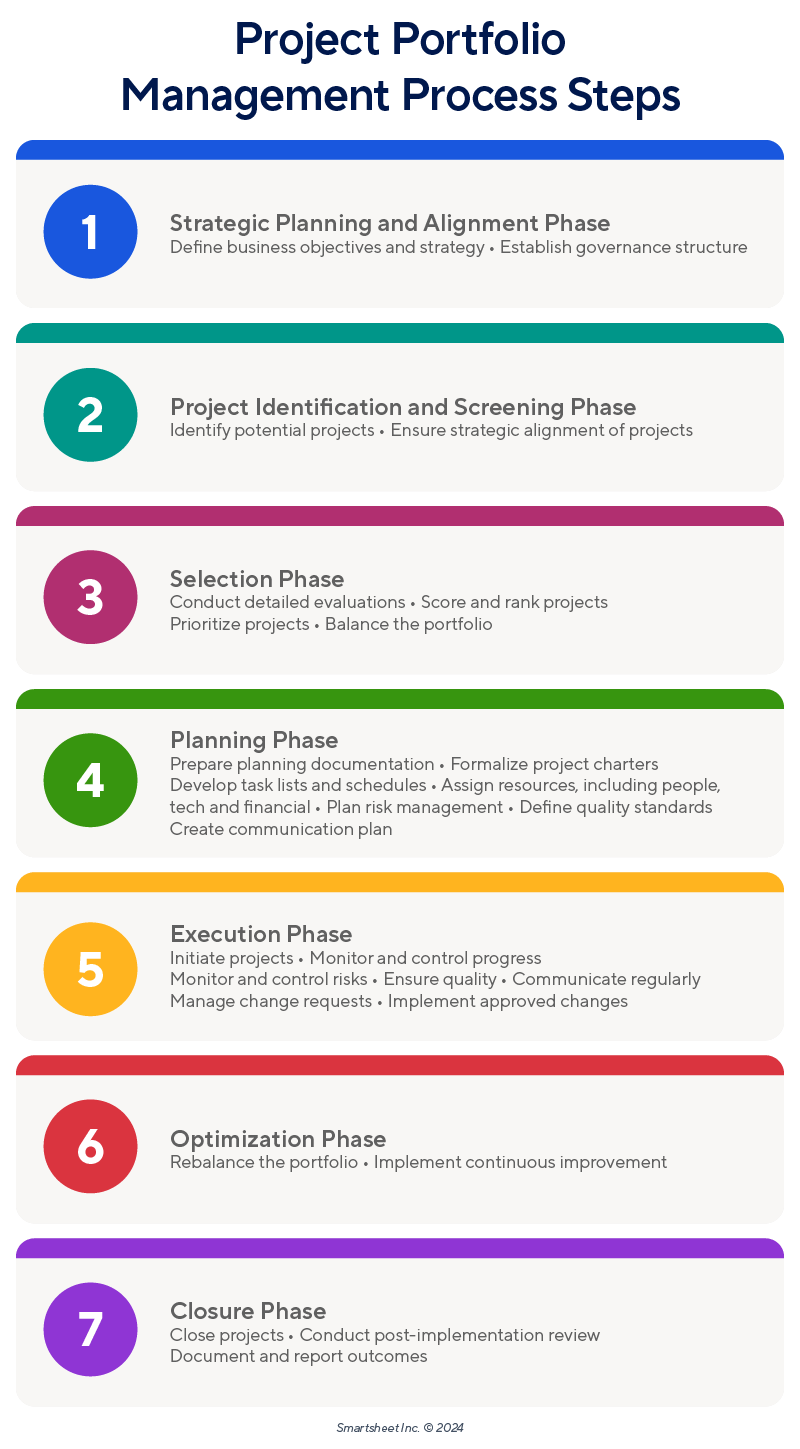What Is the Project Portfolio Management Process?
The project portfolio management (PPM) process is a continuous, structured approach to managing a collection of projects while ensuring alignment with company strategy. It involves a series of phases and steps that guide organizations in selecting, prioritizing, and managing projects to achieve their strategic objectives.
PPM’s popularity grew over the years due to dissatisfaction with traditional project management's lack of emphasis on business results. In a 2002 paper for the Project Management Institute Annual Seminars and Symposium, author Jean Miller asks, "Are you doing the right things, or just doing things right?” Miller continues by writing, “Similar to your personal financial portfolio, your IT projects are investments and fall into a portfolio in which you must manage risk and enhance your return and value.”
Today, the project portfolio management process takes on different flavors in different industries and companies. Still, it adheres to bedrock principles of strategic alignment, well-defined process phases, and focus on business success.
The Modern Project and Portfolio Management Handbook
A modern approach to project and portfolio management can help equip you and your teams to tackle projects and programs at scale.

This handbook will help you:
Identify pain points in your current processes
Learn from examples of businesses using modern PPM strategies
Implement your own updated PPM strategy
7 Main Phases of Project Portfolio Management
Experts divide the project portfolio management process into seven main phases. The first phase is strategic planning and alignment. The next two phases are project identification and selection, then project planning, execution, and optimization follow. The final phase is closure.
Here’s a closer look at the seven main phases of project portfolio management:
- Strategic Planning and Alignment: Company leaders set business objectives and devise a strategy to achieve them. The organization then uses the PPM process to choose, plan, and execute projects that support that strategy.
Large companies using enterprise project portfolio management will typically create a project management office (PMO) to guide the process. The structure often includes portfolio managers with project managers under them. This governance structure ensures that PPM processes and projects remain on track and that companies adjust them as necessary to meet their objectives. Learn more in this comprehensive guide to enterprise PPM. - Project Identification: In this phase, people throughout the company identify potential projects to achieve the business objectives. They gather enough detail and projections to determine if a project merits further consideration. Organizations may use an initial screening process based on ROI, strategy alignment, cost, risk, and other factors.
- Project Selection: In the selection phase, projects undergo a more thorough evaluation. Organizations delve deeper into ROI projections, costs, risks, strategic alignment, market conditions, and other factors. They often use a scoring system to prioritize projects. They also consider portfolios of projects and how they might work in tandem, not in conflict. This is called portfolio balancing. Larger companies may have multiple portfolios, each requiring a balance of projects.
- Planning: After selection, it’s time for project planning. This means creating detailed documentation with project charters, resource allocation, risks, timelines, milestones, intended results, communication plans, and more. Without sufficient planning, projects can run over budget, miss deadlines, and fail to achieve the intended results.
- Execution: Project execution begins with a formal kickoff. Organizations often divide individual tasks into sprints or phases to make them more manageable and ensure the achievement of interim milestones. Individuals responsible for tasks work to meet deadlines and achieve expected results. This phase includes constant monitoring for roadblocks, delays, or cost overruns.
- Optimization: Teams make necessary adjustments based on the performance metrics of the portfolio and its projects. The changes could involve reallocating resources, rebalancing the portfolio, or adjusting the individual project plans.
- Project Closure: Projects should have a clear beginning and end. In the closure phase, project leaders ensure they’ve completed the deliverables and report on key project metrics and results. They conduct a retrospective to glean lessons for future projects. They formally close the project and end the work on it.
When implemented effectively, these phases of the project portfolio process ensure a holistic, strategic approach to achieving company goals.
| Phases | Highlights | |
|---|---|---|
| 1 | Strategic Planning and Alignment | Executives set business objectives and strategic plans. |
| 2 | Project Identification | People throughout the company identify potential projects aligned with the selected objectives. |
| 3 | Project Selection | The project management office (PMO) evaluates, scores, and selects projects. |
| 4 | Planning | The PMO team creates project charters and timelines, and allocates resources. |
| 5 | Execution | Teams initiate project tasks to meet deadlines and milestones. |
| 6 | Optimization | Teams adjust as necessary to handle roadblocks, delays, or changes. |
| 7 | Closure | Teams close projects after ensuring deliverables are met, then conduct retrospectives. |
Steps in the Project Portfolio Management Process
The project portfolio management process begins at the executive level in the strategic planning phase. The steps then flow through the phases of project identification, selection, planning, execution, optimization, and closure.
Here’s a detailed look at the steps in the project portfolio management process through each PPM phase:
1. Strategic Planning and Alignment Phase
During this phase, executives set goals and develop a broad strategy.
- Define Business Objectives and Strategy: Executives define the organization's high-level business objectives and strategy. One common approach is called objectives and key results (OKRs).
Everything starts with the organization’s objectives. These will periodically change, spawning new projects to support them. Often, a market change will precipitate a change in direction.
“PPM is a large commitment for an organization and works best when you have a leadership team that is aligned on the company's strategic goals,” says Lulu Richter, Senior Technical Project Manager at Smartsheet. “I've been part of PPM solutions where rapidly shifting company strategy invalidated months of work. Teams can strive to be agile, but are most effective when guided by strong business strategy.”
- Establish Governance Structures: Define roles, responsibilities, and authority levels for project portfolio management to ensure alignment with business strategy.
This step happens when an organization commits to project portfolio management. It likely will create a project management office (PMO) or similar team to run portfolios and projects within it. Learn more in this article on how to implement PPM at your organization.
Companies should regularly review the workings of the PPM structure and processes to ensure they’re working optimally.
2. Project Identification and Screening Phase
In this phase, the portfolio team gathers and screens potential projects.
- Identify Potential Projects: Collect and document potential projects from across the organization.
- Ensure Strategic Alignment of Projects: Verify that potential projects align with business objectives and strategic goals.
One example of strategic alignment comes from a non-traditional field for PPM: entertainment. “One of the most critical aspects of effective PPM is ensuring that the projects you choose to pursue are aligned with your organization's strategic objectives,” says Daniel Meursing, Founder and CEO of Premier Staff, an event staffing agency.
“While the glitz and glamor of Hollywood may seem far removed from the world of PPM, the truth is that the principles of effective resource allocation, risk management, and strategic alignment are universal, whether you're managing a high-profile event or a complex portfolio of projects.”
- Conduct Initial Screening: Perform a high-level assessment to determine if the projects are feasible and worth pursuing. This isn’t a full-fledged evaluation, only a screening to determine if a project merits further consideration. This narrows the field for time spent on detailed evaluations.
3. Selection Phase
In the selection phase, the portfolio team evaluates, prioritizes, and chooses projects for the portfolio.
- Conduct a Detailed Evaluation: Assess each project in detail based on various criteria such as expected benefits, costs, risks, scope, resource requirements, and alignment with strategic objectives.
“At Premier Staff, we receive countless requests to staff events ranging from intimate celebrity gatherings to large-scale corporate conferences,” says Meursing. “To determine which opportunities to pursue, we have a rigorous project selection process that evaluates each potential project against a set of predefined criteria, including alignment with our core values and mission, potential for long-term client relationships, resource requirements and capacity constraints, and financial viability and profitability. By consistently applying this framework, we've been able to build a portfolio of projects that not only drives revenue growth but also reinforces our brand identity and market positioning.”
- Score and Rank Projects: Use scoring models, weighted criteria, or other evaluation methods to rank projects based on their assessed value and strategic fit.
“I've found that a good project selection process can increase ROI as it emphasizes the use of data-driven decision-making,” Richter says. “Scoring models are particularly effective at translating qualitative data into a quantitative format, which in turn allows you to more easily compare the relative value of projects.”
- Prioritize Projects: Prioritize projects based on their rankings and the organization's capacity to execute them.
“It's important to pick projects that align with our goals, meet market demand, and use our resources well,” says Ozzy Akpek, CEO of Smile Art Design, a creative agency that works with businesses. “By focusing on projects with the highest potential for success, we can achieve great results.”
- Balance the Portfolio: Ensure a balanced portfolio by considering resource availability, risk distribution, strategic alignment, and other factors.
“Effective and efficient project portfolio management relies heavily on portfolio balancing,” says Daniel Kroytor, Director at TailoredPay, a payment processing solution. “Without it, the entire PPM model falls apart and minimal progress will be had.”
Kroytor stresses the importance of dividing attention between multiple projects. “Think about it this way — should a portfolio manager, or PM, spend 18 hours a day on a single project, their other responsibilities would fall to the wayside,” he says. “Meetings will not take place. Deadlines will be missed. Employees will be confused. On a larger scale, this poses a number of issues, the most pressing of these being resource mismanagement. Put simply, this is the last thing any company wants to happen with the resources entrusted to them.
”Meursing also uses portfolio balancing at his events company. “At Premier Staff, we've learned that having a diverse mix of projects — from high-profile, one-time events to ongoing, steady-state contracts — is essential for managing risk and optimizing our resources,” he says. “While staffing the Oscars or the Emmys may bring prestige and exposure, these one-off events also carry a higher degree of risk and can strain our resources if not managed carefully. On the other hand, our long-term partnerships with brands like Nike and Disney provide a stable foundation of recurring revenue and allow us to plan our staffing and operations more effectively.”
4. Planning Phase
In the planning phase, the team develops project plans and allocates resources.
- Prepare Planning Documentation: Project and portfolio team members prepare planning documents to guide projects.
“It can be tempting to jump straight into execution, but proper planning for any project will improve the quality of your output,” Richter says. “This phase is particularly vulnerable to bloat, so it's important to assess what specific planning tasks are required on a project-by-project basis. Personally, I leverage a library of templates that I can quickly generate and use as a general roadmap for my planning activities.”
Look through this collection of free, downloadable PPM templates to find the best resource for your company.
- Formalize Project Charters: Write a charter for each project in the portfolio to detail key aspects of the project so there’s no confusion over its scope, objectives, deliverables, deadlines, risks, and budget.
- Develop Task Lists and Schedules: Create detailed project schedules, including timelines, milestones, and dependencies.
- Allocate Resources: Assign financial, human, and technological resources to the selected projects based on priority and needs.
“There are a couple keys to steering clear of resource mismanagement,” says Kroytor of TailoredPay. “For starters, organization is king. From defining goals to setting target allocations to simple note taking, quick and easy access to all relevant information is the gold standard. Additionally, there should be involvement with the stakeholders. After all, they are a vital cog in this machine.”
- Plan Risk Management: Identify potential risks for each project and develop mitigation plans.
“Identifying and planning for potential risks upfront is crucial,” says David Pumphrey, CEO of RiverAxe, a healthcare IT company. “In my experience, creating a risk register and involving the team in regular risk assessment meetings helps in proactively addressing issues before they escalate. This approach minimizes disruptions and keeps projects on track.”
- Define Quality Standards: Establish quality standards for portfolio projects and measure work against them.
Plan Communication: Develop a communication plan that outlines how to inform stakeholders.
“A well-defined communication plan ensures that all stakeholders are informed and engaged,” Pumphrey says. “Regular updates, clear documentation, and setting expectations early on are key. During my AV projects, consistent communication with clients and team members helped in maintaining transparency and trust.”
5. Execution Phase
In this phase, project tasks begin with well-defined controls and reporting.
- Initiate Projects: Formally kick off projects, ensuring all stakeholders are informed and involved. Organizations often hold kickoff meetings to review the project charter, engage the team, and answer questions about the project.
- Monitor and Control Progress: Continuously monitor project progress, manage changes, and ensure projects stay on track regarding scope, time, cost, and quality.
“There is not a single execution methodology that works for all projects, and part of project planning should be determining which work management style best fits your unique situation,” Richter says. “No matter what approach you take, I've found the most success when you collaborate with functional teams to understand their work management preferences and pain points.”
- Monitor and Control Risks: Monitor risk triggers and implement contingency plans as necessary.
- Ensure Quality: Implement processes to ensure projects adhere to the defined quality standards and take corrective actions if necessary.
“Ultimately, the success of any PPM process comes down to the ability to execute projects effectively and efficiently,” says Meursing. “At Premier Staff, we've found that the key to successful project execution lies in two critical areas: empowering our teams and leveraging technology.”
- Communicate Regularly: Maintain regular communication with stakeholders to provide updates on project status, risks, and issues.
- Manage Change Requests: Establish a process for submitting, reviewing, and approving changes to the portfolio.
- Implement Approved Changes: Execute approved changes and update portfolio plans accordingly.
6. Optimization Phase
In this phase, managers may add, delay, or cancel projects based on execution results and changing priorities. They also may adjust processes.
- Rebalance the Portfolio: Reassess and adjust the portfolio to maintain a balance of project types, risks, and resource allocation.
“By continuously monitoring and adjusting our portfolio mix, we've been able to achieve a balance that maximizes our profitability, mitigates risk, and ensures that we have the right resources in place to deliver exceptional service to all our clients,” Meursing says.
- Implement Continuous Improvement: Apply lessons learned and best practices to improve the PPM process continuously.
7. Closure Phase
In this phase, project teams end their work and conduct retrospectives.
- Close Projects: Formally close projects after confirming the team has completed its work.
- Conduct Post-Implementation Review: Review completed projects to assess their success and identify lessons learned. Implement a mechanism for gathering and addressing stakeholder feedback to inform future projects.
“As a project manager, it's easy to reduce your projects into successes and failures,” says Richter. “The project closure process gives space for those shades of gray, allowing you to collect input that fuels continuous improvement and makes the next initiative all the more effective.”
- Document and Report Outcomes: Document project outcomes, performance metrics, and insights gained for future reference and reporting to stakeholders.
“We need to evaluate what worked and what didn't to learn and improve,” says Akpek of Smile Art Design. “By analyzing project outcomes, we can make our PPM process better and drive future success.”
Project Portfolio Management Process Starter Kit

Download the PPM Process Starter Kit
This starter kit provides what you need to plan, communicate, and track your organization’s project portfolio management process.
In this kit, you’ll find:
- A project scorecard template for Excel to help you evaluate and select projects for a portfolio in the selection phase.
- A PPM tracker template for Excel to provide a visual timeline for multiple projects in the planning phase.
- A project portfolio budget tracking template for Excel for a detailed view of costs, expenses, spending, and outstanding balance for the resource allocation phase.
- A project portfolio management dashboard for Excel that shows the portfolio’s timeline, resource allocation, financial status, risk analysis, issues, and pending actions for the planning and execution phases.
- A project portfolio status template for Excel for automatically calculating budgeted costs, actual costs, a financial forecast, and variance.
Best Practices for Project Portfolio Management Process
In order to get the most out of PPM, some best practices to follow include aligning projects with strategic goals, continuously monitoring progress, and implementing Lean methodology across your projects.
Here’s a detailed look at common best practices for the project portfolio management process:
- Align Projects with Strategic Goals: Ensure all projects align with strategic objectives and business goals. Regularly review and adjust the portfolio to maintain strategic alignment.
- Establish Strong Governance: Create a project management office (PMO) to oversee portfolio management processes and ensure alignment with business strategy. Define clear roles, responsibilities, and decision-making authority for managing the portfolio. Some experts recommend pushing down authority and accountability to foster a culture of ownership and engagement.
- Comprehensive Evaluation and Prioritization: Implement criteria for evaluating and prioritizing projects based on factors such as strategic fit, value, risk, and resource requirements. Use scoring models to assess and rank projects objectively.
- Effective Resource Management: Optimize resources across the portfolio to avoid bottlenecks. Forecast resource needs and plan capacity to ensure that the organization can support prioritized projects.
- Continuous Monitoring and Control: Establish processes for monitoring project performance, including regular progress reviews and risk assessments. Use key performance indicators (KPIs) and other metrics to track performance.
- Transparent Communication: Provide updates on project status, risks, and issues to stakeholders. Develop dashboards to show progress against goals.
- Risk Management: Assess and manage risks at the project and portfolio levels. Implement strategies to mitigate risks.
- Agile and Adaptive Processes: Incorporate process flexibility to adapt to changing business needs and external conditions. Regularly adjust the portfolio to respond to new opportunities, risks, and priorities.
- Benefit Realization and Measurement: Define expected benefits for each project and track progress. Use KPIs to measure the success of projects and their contributions to strategic objectives.
- Continuous Improvement: Implement lessons learned and best practices to improve the PPM process continuously. Conduct post-implementation reviews to capture insights and apply them to future projects.
- Sustainability and Environmental Considerations: Evaluate projects for their environmental impact and sustainability.
- Structured Decision-Making: Establish a structured decision-making framework to ensure consistency, transparency, and alignment with strategic goals. Use data-driven insights and quantitative methods to inform decisions, balancing qualitative judgments with objective analysis.
- Lean Methods to Avoid Bureaucracy: Implement Lean principles to streamline processes, eliminate waste, and increase efficiency within the PPM process. Focus on value-added activities and reduce non-value-added tasks to minimize bureaucracy. Empower team members to continually improve the process.
“At Premier Staff, our commitment to disciplined PPM has been a key driver of our growth and success over the past decade,” says Meursing. “By consistently applying best practices across project selection, planning, execution, and closure, we've been able to scale our operations, expand our client base, and establish ourselves as a leader in the event staffing industry.”
These best practices also generally apply to the related areas of product and IT portfolio management. These forms of portfolio management share common goals of strategic alignment, resource optimization, and risk management. However, they differ significantly in their focus areas, applications, and specific metrics. Learn more in these articles on product portfolio management and IT portfolio management. You can also check out these product portfolio management templates to help you organize and manage any portfolio.
Get the Most Out of the PPM Process with Smartsheet for Project Management
From simple task management and project planning to complex resource and portfolio management, Smartsheet helps you improve collaboration and increase work velocity -- empowering you to get more done.
The Smartsheet platform makes it easy to plan, capture, manage, and report on work from anywhere, helping your team be more effective and get more done. Report on key metrics and get real-time visibility into work as it happens with roll-up reports, dashboards, and automated workflows built to keep your team connected and informed.
When teams have clarity into the work getting done, there’s no telling how much more they can accomplish in the same amount of time. Try Smartsheet for free, today.





